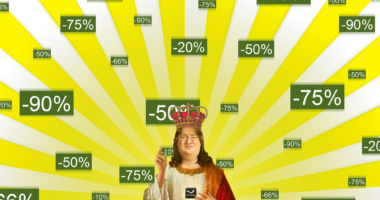
Christie’s is selling digital art. Kings of Leon are offering their latest album as a collector’s item—online. And NBA fans recently drove the price of a LeBron James highlights video into six figures.
Behind all three: a new asset that uses the technology backing cryptocurrencies to create unique “non-fungible tokens.” Collectors can use the tokens attached to these assets to verify the authenticity of everything from artworks to sports highlights.
Bidding for Christie’s first non-fungible token, a digital collage by Mike Winkelmann, hit $3 million with the auction still ongoing. The creator of the Nyan Cat meme, which features an animated cartoon cat with a Pop-Tart for a torso, sold an non-fungible token for 300 ether last month, equivalent to nearly $600,000 at the time of sale.
Here is what you need to know about this new market.
What is a non-fungible token and what do they do?
Non-fungible tokens are similar to bitcoin and other cryptocurrencies, with a key difference: while every bitcoin created can be exchanged for one another, these can’t. As the name suggests, non-fungible tokens are meant to be unique.
The tokens act as virtual deeds, conveying ownership of a digital asset. Each one gets uploaded to a digital ledger where it conveys key information: the date it was created, when it was sold, for how much and to whom.
In some designs, these bits of information are conveyed through a cryptographic hash function, an algorithm that takes this information and converts it into an unique identifier. The slightest change in that information would generate a different identifier. This allows would-be buyers to ensure an asset hasn’t been tampered with. In other designs, the metadata is stored independently.
“Think of it like a digital passport that comes with an asset,” said Nadya Ivanova, chief operating officer of BNP Paribas-affiliated research firm L’Atelier. “They allow for this trust and authenticity to be established in a way that we haven’t been able to do before, whether it’s with physical assets or digital assets.”
What do you get when you buy a non-fungible token?
Non-fungible tokens allow people to buy provably original versions of everything from digital art to pop albums.
Unlike other high-price digital gaming accessories, only one person can truly own digital assets backed by non-fungible tokens. Individual investors trading on digital online marketplaces, such as Nifty Gateway or OpenSea, receive a token for the asset to their single address—the unique identifier for a cryptocurrency account that lets other people find the account on the network.
Many marketplaces also provide a digital rendering of the asset, whether it is an image file depicting a work of art or a video of a basketball highlight. Some artists, like Mr. Winkelmann, work with the buyers of these tokens to display digital art in the physical world, whether that is through a digital frame or projecting the painting on a building.
Why are non-fungible tokens getting so much attention?
The first non-fungible tokens started appearing late 2017, according to research by NonFungible.com and L’Atelier. The market has expanded in three years and attracted the attention of big names such as Christie’s and the NBA. Rock band Kings of Leon recently announced it would release an album as a non-fungible token, effectively letting someone own the first edition of the digital collection.
The newfound attention on digital collectibles has boosted prices. The average cost of digital trading cards on the platform Gods Unchained rose by 69% to $18.24 by the last quarter of 2020 from $10.82 in the first quarter, according to data from NonFungible.com. The average cost of digital real estate in the online game The Sandbox rallied 88% over the same period, to $59.19.
What is the ethereum network?
Many of the non-fungible tokens being created are on the ethereum network.
While bitcoin’s blockchain was created to store transaction values and track the movement of bitcoin between accounts, the ethereum network has a broader focus. Ethereum acts as a software platform where developers can store computer code for other blockchain projects.
That makes it much more flexible, allowing it to facilitate the exchange of items beyond cryptocurrencies. Ethereum is used to create financial contracts and applications for computers and mobile phones.
How big is the non-fungible token market?
The non-fungible token market ballooned over 2020, climbing to a market value of at least $338 million, from about $41 million in 2018, according to a report by NonFungible.com and L’Atelier. The surge in interest led to the expansion of online marketplaces.
The market remains a fraction of bitcoin’s size, despite the high prices being fetched for some non-fungible tokens. The value of all bitcoin in circulation was $926 billion on Monday, with one bitcoin worth $49,677.39.
What is the risk in buying a non-fungible token?
Crypto assets have gone through their share of frenzies over the years, with whipsawing prices causing investor losses.
In 2017 and 2018, many poured money into cryptocurrency startups through a controversial fundraising method called initial coin offerings. Such booms preceded a rise in trading groups that manipulated the price of cryptocurrencies, causing losses for others.
The value of these digital collectibles depends on the assumption that someone else is willing to pay more for it than you did, analysts say, noting similarities between their big gains and recent social-media-fueled frenzies in meme stocks like GameStop and Koss that led to heavy losses for some individual investors.
“There are people who have been conditioned by cryptocurrencies to believe that just the fact that it can be owned makes it valuable,” said Jorge Stolfi, a computer science professor at Brazil’s State University of Campinas. “People just 100% believe that this thing has value, but in fact it doesn’t because there’s no way to get value out of it except for selling it to another investor.”
Write to Caitlin Ostroff at [email protected]
Copyright ©2020 Dow Jones & Company, Inc. All Rights Reserved. 87990cbe856818d5eddac44c7b1cdeb8
This post first appeared on wsj.com








